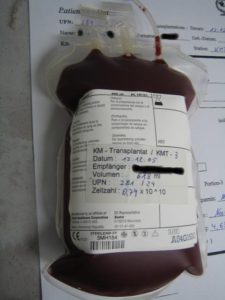
Recently Diagnosed or Relapsed? Stop Looking For a Miracle Cure, and Use Evidence-Based Therapies To Enhance Your Treatment and Prolong Your Remission
Multiple Myeloma an incurable disease, but I have spent the last 25 years in remission using a blend of conventional oncology and evidence-based nutrition, supplementation, and lifestyle therapies from peer-reviewed studies that your oncologist probably hasn't told you about.
Click the orange button to the right to learn more about what you can start doing today.
- You are here:
- Home »
- Blog »
- Multiple Myeloma »
- Tandem Stem Cell Transplant in MM- “Only Minor Advantage in Overall Survival”
Tandem Stem Cell Transplant in MM- “Only Minor Advantage in Overall Survival”

However, the authors caution that this advantage (tandem stem cell transplant in MM) translated to only a minor advantage in overall survival.
A “tandem stem cell transplant” is just like it sounds. Not one but two stem cell transplants, usually a few months apart. The key to the study below is that it examines
- auto-auto (autologous- your own stem cells) and
- auto-allo (allogeneic- using a donor’s stem cells).
Both in the case of multiple myeloma (MM).
The other important concept is PFS (progression-free survival) and OS (overall survival). PFS is defined as the time before your MM progresses- in short, the length of your first remission. OS is your length of life after you’ve been diagnosed with multiple myeloma.
My personal experience as well as my experience working with other multiple myeloma patients is that the risk of serious adverse events (side effects) greatly outweighs the “minor advantage in overall survival.”
Yes, a MM patient who undergoes a tandem SCT, will, on average, achieve a longer first remission. But the short, long-term and late stage side effects from the high-doses of chemotherapy that accompany tandem stem cell transplants, according to the study, will give the MM patient only a minor increase in OS, or length of life.
An important study, excerpted below, identified the fact that most MM patients learn about short, long-term and late stage side effect of therapy only after they have undergone lots of chemo/toxicity.
“During the interviews, patients indicated that fatigue, musculoskeletal pain, gastrointestinal symptoms, neuropathy, and neutropenia were common physical side effects. They also reported numerous cognitive side effects of treatments, including difficulty concentrating and memory lapses, as well as emotional and psychological side effects, such as mood swings. According to the researchers, these side effects often resulted in broader implications relating to quality of life, with patients reporting disruptions in social relations and their ability to work and pursue other valued activities.”
If you are like me, you want to do everything, undergo the most extreme therapies, if it means that you could “beat myeloma.” Now that I’ve lived with the short, long-term and late stage side effects that accompany induction, consolidation, high-dose chemotherapy (single SCT, not tandem), I look at aggressive MM therapies differently.
I think you may too want to “beat myeloma.” But may see the world differently after you live with the short, long-term and late stage side effects that accompany stem cell transplants.
The challenge with tandem transplants is that once you’ve undergone these therapies, the die will be cast. You can’t un-do this treatment.
And the kicker is that you can probably achieve as long a PFS and OS by undergoing the the many “novel” therapies that have been approved by the FDA in the past dozen or so years. Ask a MM specialist.
And don’t get me started taking about the evidence-based, non-toxic, non-conventional MM therapies. One of which put me in complete remission from my end-stage MM in ’99.
If you want to go “all- in,” as they say, if you want to undergo the most aggressive MM therapies possible in hopes of the longest overall survival, a tandem transplant is for you.
Have you been diagnosed with multiple myeloma? What stage? What symptoms? Are you considering a single or tandem transplant? Scroll down the page, post a question or comment and I will reply to you ASAP.
Hang in there,
David Emerson
- MM Survivor
- MM Coach
- Director PeopleBeatingCancer
Recommended Reading:
- Multiple Myeloma Diagnosis- Can’t Trust Conventional Cancer Research
- Cancer Prehabilitation-
- Relapsed/Refractory Multiple Myeloma- Patient Preferences
Tandem Transplant Strategies Associated With Higher Progression-Free Survival in Patients With Multiple Myeloma
Several treatments are available for multiple myeloma:
- autologous hematopoietic stem cell transplantation (auto-HSCT),
- allogeneic (allo-HSCT),
- tandem auto-HSCT, or
- auto-allo-HSCT approaches.
Although auto-HSCT remains the gold standard of treatment, there is no clear consensus on the advantages and/or disadvantages of each approach…
The study included:
- 24,936 patients who underwent auto-HSCT,
- 3683 patients who then proceeded to undergo an elective tandem auto-HSCT, and
- 878 patients who underwent an auto-allo-HSCT.
The authors compared the results of each treatment using landmark analysis, and 2 dynamic prediction models to predict long term outcomes while adjusting for possible information loss during landmark analysis. A third model accounted for the long-term effect of undergoing tandem treatments at different times.
Approximately 18% of patients were in complete remission after the first auto-HSCT. “Younger age and being in clinical remission at first transplant were consistently found to be positive prognostic factors for progression-free survival and overall survival,” noted the study authors. Patients who sought a tandem auto or auto-allo treatment were less likely to achieve complete remission (9% and 8% of patients, respectively).
Disclosure: Multiple authors declared affiliations with industry. Please refer to the original abstract for a full list of disclosures.



